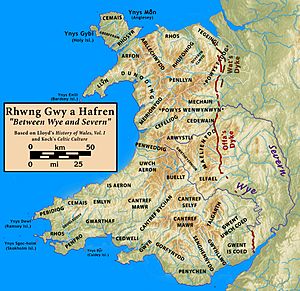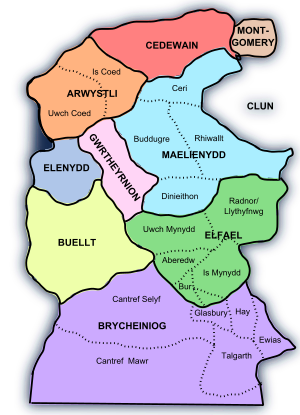Gwrtheyrnion facts for kids
Gwrtheyrnion (or Gwerthrynion) was a small area in Mid Wales during the Middle Ages. It was located north of the River Wye, and its main town was Rhayader. People say its name came from a legendary king called Vortigern. For a long time, Gwrtheyrnion was connected to other small kingdoms like Buellt and Elfael. Their rulers were quite independent. Later, when the Normans arrived, Gwrtheyrnion became part of the lands controlled by powerful Norman lords.
Contents
What's in a Name?
The name Gwrtheyrnion comes from the legendary King Vortigern. An old book from the 9th century, called the Historia Brittonum, says that Gwrtheyrnion was named after him. Historians believe this is true.
Gwrtheyrnion was surrounded by other areas: Arwystli to the north, Maelienydd to the east, Elfael to the southeast, and Buellt to the southwest. It also controlled an area called Deuddwr, which was west of the River Wye. Together, Gwrtheyrnion and Deuddwr formed a larger region.
A Look Back in Time
Early Rulers
The Historia Brittonum is the first place we hear about Gwrtheyrnion. It tells a story that King Vortigern fled to Gwrtheyrnion. After he died, his son, Pascent, was given Gwrtheyrnion and Buellt.
Later, the rulers of Gwrtheyrnion were said to be descendants of Vortigern through Pascent. This line of rulers eventually ended with a person named Ffernfael ap Tewdwr around the early 9th century.
After Ffernfael, Gwrtheyrnion (along with Buellt) changed hands a few times. For a while, it was part of Seisyllwg, and then it came under the control of Arwystli. When Arwystli's ruler, Iorwerth Hirflawdd, died, his lands were divided. Buellt and Gwrtheyrnion went to his son, Cadwr Gwenwyn.
Cadwr's grandson, Elystan Glodrydd, became an important ruler. He conquered nearby lands and added them to his own kingdom. Elystan was followed by his son, Cadwgan, and then his grandson, Idnerth.
Norman Influence
When the Normans invaded England, many Welsh princes helped fight against them. Because of this, the Normans decided to take over Wales in 1080 to stop the Welsh from helping their enemies. This led to a big Welsh rebellion in 1094, but the Normans eventually put it down.
A Norman lord named Philip de Braose took control of some southern parts of the region. Eventually, Idnerth, the Welsh ruler of Gwrtheyrnion, made a deal with the Normans. Idnerth got Gwrtheyrnion back, but Braose kept parts of Buellt.
After Idnerth and his son Madog died, the lands were divided again among Madog's sons. Cadwallon ap Madog received the northern part, which became Maelienydd. The rest, Elfael, went to his brother, Einion Clud.
Einion o'r Porth, another ruler, married Susanna, the daughter of Rhys ap Gruffydd, a powerful Welsh prince. In 1177, Rhys ap Gruffydd built Rhayader Castle in Gwrtheyrnion.
Later, Einion was murdered by his own brother, Gwalter. Another brother, Iorwerth Clud, took over with help from Reginald de Braose and Llywelyn Fawr, a very powerful Welsh prince. However, Llywelyn's son, Dafydd ap Llywelyn, later lost control of Elfael to a Norman lord, Ralph Tosny. But Dafydd's nephew, Llywelyn ap Gruffudd, managed to win it back. The English King Henry III even recognized Llywelyn ap Gruffudd's victory.
However, when Llywelyn ap Gruffudd married the daughter of King Henry's enemy, the new English King, Edward I, declared Llywelyn a rebel. Edward attacked Llywelyn's lands, forcing him to sign a treaty in 1277. This treaty made Llywelyn a vassal (a ruler under the king's authority) and limited his power to just Gwynedd. Elfael was given back to Ralph Tosny's grandson.
Becoming Part of Wales
In the 15th century, the lands controlled by the Tosny family were inherited by Margaret Beauchamp of Bletso. Eventually, these lands, including Gwrtheyrnion, passed to her great-grandson, King Henry VIII.
After Henry VIII passed the Laws in Wales Acts 1535 and 1542, Gwrtheyrnion and the surrounding areas became part of a new county called Radnorshire. In 1996, Radnorshire, along with Montgomeryshire and Brecknockshire, became the main parts of the modern county of Powys.

Images for kids




